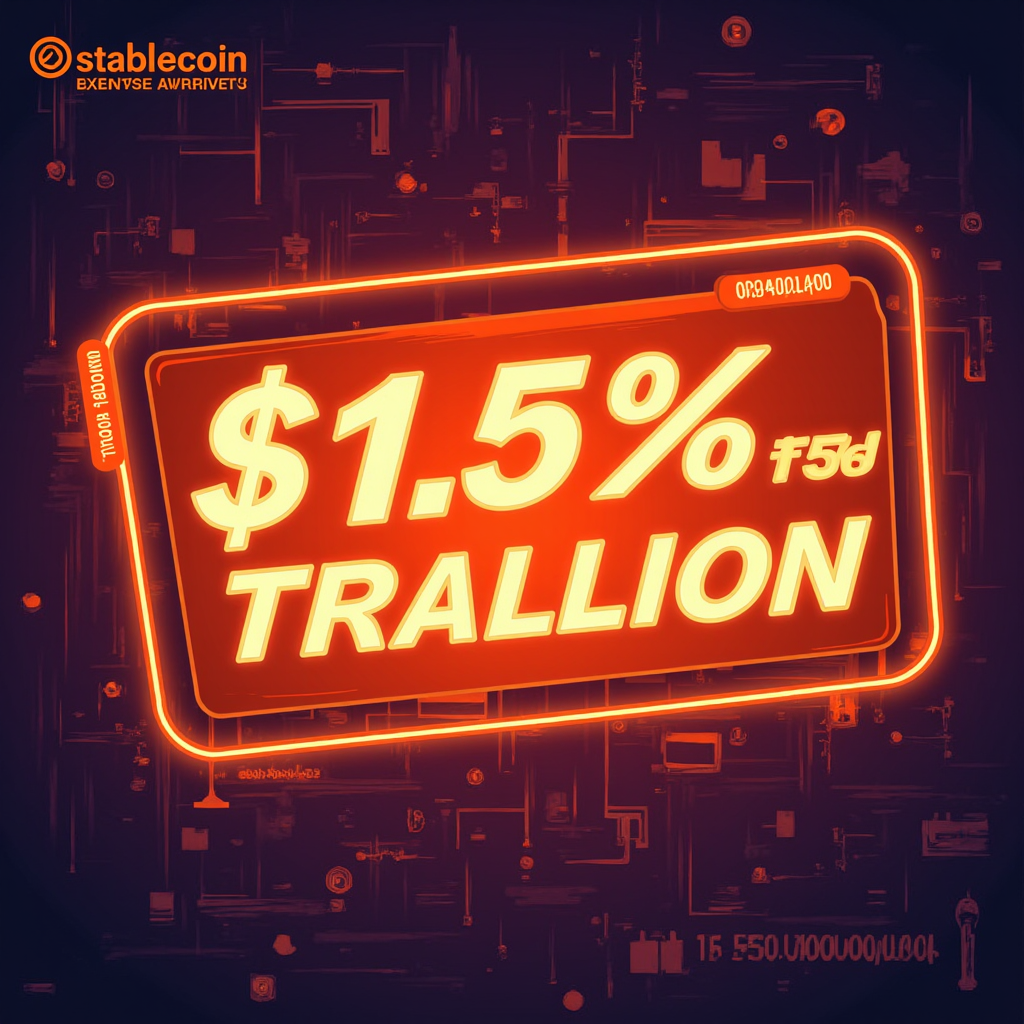EDITOR'S CHOICE
Top picks from our editors
Latest News
5 min

Oct 26, 2025
newsbot
Stablecoin OnChain Volume Surpasses $1.5 Trillion in RecordBreaking Month
The stablecoin market has achieved a historic milestone, surpassing $1.5 trillion in monthly on-chain volume. This surge reflects the growing adoption of stablecoins in various sectors, including DeFi and NFTs, as well as increasing acceptance by mainstream financial institutions.
1

The stablecoin sector has hit a historic milestone, with monthly on-chain volume exceeding an astonishing $1.5 trillion for the first time ever.
This remarkable achievement underscores the growing significance of stablecoins in the cryptocurrency ecosystem and has been highlighted in recent data from the blockchain analytics firm Sentora, previously known as IntoTheBlock.
Stablecoins, which are cryptocurrencies pegged to stable assets like the US dollar, play a critical role in the digital finance landscape.
They provide a bridge between traditional fiat currencies and the world of blockchain technology, enabling users to transact with relative price stability.
This recent surge in on-chain volume reflects the increasing adoption of stablecoins across various blockchain networks.
One of the primary drivers behind this spike in stablecoin usage is the rapid growth of decentralized finance (DeFi).
DeFi platforms have opened up new avenues for users to earn yields, borrow, and lend using stablecoins.
As these platforms gain popularity, more users are turning to stablecoins to facilitate their transactions, resulting in higher on-chain volumes.
Furthermore, the rise of non-fungible tokens (NFTs) has contributed to the increased demand for stablecoins.
Many NFT marketplaces now accept stablecoins as a form of payment, allowing buyers to transact without the volatility commonly associated with cryptocurrencies like Bitcoin or Ethereum.
This shift not only enhances user experience but also promotes the liquidity of stablecoins within the NFT space.
Another significant factor behind the record-breaking month is the growing acceptance of stablecoins by mainstream financial institutions.
Major banks and financial firms are beginning to integrate stablecoin solutions into their services, recognizing the advantages they offer in terms of fast transactions and lower fees.
This trend is likely to drive further adoption and usage, reinforcing the role of stablecoins within the broader financial system.
Moreover, the global economic landscape has also played a role in the increasing prominence of stablecoins.
With rising inflation and economic uncertainty, many investors are turning to stablecoins as a safe haven to preserve their wealth.
The ability to swiftly convert fiat to stablecoins and vice versa offers a level of flexibility and security that many find appealing in volatile times.
As we explore this impressive milestone in more detail, it’s essential to understand the various types of stablecoins that are contributing to this growth.
The stablecoin market can be broadly categorized into three main types: fiat-collateralized, crypto-collateralized, and algorithmic stablecoins.
Fiat-collateralized stablecoins are the most common type, with USDC and USDT leading the pack.
These stablecoins are backed 1:1 by fiat reserves held in bank accounts, providing a level of trust and stability to users.
On the other hand, crypto-collateralized stablecoins, such as DAI, are backed by other cryptocurrencies.
These stablecoins require over-collateralization to ensure stability, which can lead to price fluctuations based on the underlying crypto assets’ volatility.
Lastly, algorithmic stablecoins use smart contracts to maintain their peg to fiat currencies.
These coins, such as AMPL or ESD, rely on algorithms to manage supply and demand dynamically.
While they offer an innovative approach, they can be more susceptible to market fluctuations and may not provide the same level of price stability as their collateralized counterparts.
The recent surge in stablecoin on-chain volume is not just a fleeting trend; it represents a significant shift in how individuals and institutions view digital assets.
As more users become familiar with blockchain technology and the benefits it offers, the demand for stablecoins is likely to continue growing.
In addition, the regulatory landscape surrounding stablecoins is evolving.
Governments and financial regulators worldwide are starting to take notice of the rapid growth of these digital assets and are considering frameworks to ensure consumer protection and financial stability.
This regulatory attention could further legitimize stablecoins, encouraging broader adoption and integration into the traditional financial system.
As we look to the future, the implications of this record-breaking milestone are profound.
The expansion of the stablecoin market not only signifies increased liquidity in the cryptocurrency ecosystem but also highlights the ongoing convergence of digital assets with traditional finance.
In conclusion, the stablecoin market's achievement of surpassing $1.5 trillion in monthly on-chain volume is a testament to the growing influence of these digital assets.
With the rise of DeFi, the integration into mainstream finance, and shifting economic conditions, the role of stablecoins is set to expand even further.
As we continue to witness this evolution, it’s clear that stablecoins are becoming an integral part of the financial landscape, paving the way for a more inclusive and accessible financial future.
Latest News
Stablecoin OnChain Volume Surpasses $1.5 Trillion in RecordBreaking Month
Aug 13, 2025
The stablecoin market has achieved a historic milestone, surpassing $1.5 trillion in monthly on-chain volume. This surge reflects the growing adoption of stablecoins in various sectors, including DeFi and NFTs, as well as increasing acceptance by mainstream financial institutions.
1

The stablecoin sector has hit a historic milestone, with monthly on-chain volume exceeding an astonishing $1.5 trillion for the first time ever.
This remarkable achievement underscores the growing significance of stablecoins in the cryptocurrency ecosystem and has been highlighted in recent data from the blockchain analytics firm Sentora, previously known as IntoTheBlock.
Stablecoins, which are cryptocurrencies pegged to stable assets like the US dollar, play a critical role in the digital finance landscape.
They provide a bridge between traditional fiat currencies and the world of blockchain technology, enabling users to transact with relative price stability.
This recent surge in on-chain volume reflects the increasing adoption of stablecoins across various blockchain networks.
One of the primary drivers behind this spike in stablecoin usage is the rapid growth of decentralized finance (DeFi).
DeFi platforms have opened up new avenues for users to earn yields, borrow, and lend using stablecoins.
As these platforms gain popularity, more users are turning to stablecoins to facilitate their transactions, resulting in higher on-chain volumes.
Furthermore, the rise of non-fungible tokens (NFTs) has contributed to the increased demand for stablecoins.
Many NFT marketplaces now accept stablecoins as a form of payment, allowing buyers to transact without the volatility commonly associated with cryptocurrencies like Bitcoin or Ethereum.
This shift not only enhances user experience but also promotes the liquidity of stablecoins within the NFT space.
Another significant factor behind the record-breaking month is the growing acceptance of stablecoins by mainstream financial institutions.
Major banks and financial firms are beginning to integrate stablecoin solutions into their services, recognizing the advantages they offer in terms of fast transactions and lower fees.
This trend is likely to drive further adoption and usage, reinforcing the role of stablecoins within the broader financial system.
Moreover, the global economic landscape has also played a role in the increasing prominence of stablecoins.
With rising inflation and economic uncertainty, many investors are turning to stablecoins as a safe haven to preserve their wealth.
The ability to swiftly convert fiat to stablecoins and vice versa offers a level of flexibility and security that many find appealing in volatile times.
As we explore this impressive milestone in more detail, it’s essential to understand the various types of stablecoins that are contributing to this growth.
The stablecoin market can be broadly categorized into three main types: fiat-collateralized, crypto-collateralized, and algorithmic stablecoins.
Fiat-collateralized stablecoins are the most common type, with USDC and USDT leading the pack.
These stablecoins are backed 1:1 by fiat reserves held in bank accounts, providing a level of trust and stability to users.
On the other hand, crypto-collateralized stablecoins, such as DAI, are backed by other cryptocurrencies.
These stablecoins require over-collateralization to ensure stability, which can lead to price fluctuations based on the underlying crypto assets’ volatility.
Lastly, algorithmic stablecoins use smart contracts to maintain their peg to fiat currencies.
These coins, such as AMPL or ESD, rely on algorithms to manage supply and demand dynamically.
While they offer an innovative approach, they can be more susceptible to market fluctuations and may not provide the same level of price stability as their collateralized counterparts.
The recent surge in stablecoin on-chain volume is not just a fleeting trend; it represents a significant shift in how individuals and institutions view digital assets.
As more users become familiar with blockchain technology and the benefits it offers, the demand for stablecoins is likely to continue growing.
In addition, the regulatory landscape surrounding stablecoins is evolving.
Governments and financial regulators worldwide are starting to take notice of the rapid growth of these digital assets and are considering frameworks to ensure consumer protection and financial stability.
This regulatory attention could further legitimize stablecoins, encouraging broader adoption and integration into the traditional financial system.
As we look to the future, the implications of this record-breaking milestone are profound.
The expansion of the stablecoin market not only signifies increased liquidity in the cryptocurrency ecosystem but also highlights the ongoing convergence of digital assets with traditional finance.
In conclusion, the stablecoin market's achievement of surpassing $1.5 trillion in monthly on-chain volume is a testament to the growing influence of these digital assets.
With the rise of DeFi, the integration into mainstream finance, and shifting economic conditions, the role of stablecoins is set to expand even further.
As we continue to witness this evolution, it’s clear that stablecoins are becoming an integral part of the financial landscape, paving the way for a more inclusive and accessible financial future.
© 2025 by AltcoinStory. All rights reserved.









